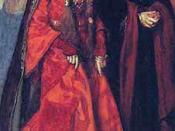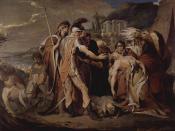"King Lear" is one of Shakespeare's most reproduced and recontextualised plays. Different productions over the years, regardless of the play's universal themes, have evolved and been informed by the social and political constructs and values of their time, emphasising the binaries of blindness and sight, chaos and order and good and evil. It is the ideas, which are universal; the text, which is unstable and can therefore be adapted to different contexts the language, especially the imagery and symbolism, still richly reinforce the ideas being explored; and finally, the different ways of presenting the play on the stage in different contexts (because of the inherently unstable text), and the use of the contemporary medium of film, that ensure that the play will continue to be relevant in modern times.
Firstly, the binaries of chaos/order, good/evil and blindness/sight, along with the themes that are presented in the early scenes of the play, are equally as applicable now as they were in the 17th Century, as they can be interpreted and valued in so many different ways.
Richard Eyre's 1998 production places an emphasis on family relations in a psychological framework, and his decision to stage the Act 1 Scene 1 love test around an iconic white table reflects this, alluding to the family dinner table. Lear is portrayed as irresponsible, manipulative and emotionally naive with his announcement to divide his kingdom among his daughter according to their professions of love. Further, Eyre alludes to what he sees as Lear's bullying of Gonerill as the oldest daughter, his manipulation of Regan as the middle daughter and his unquestioning love for Cordelia, who Lear offers "a third more opulent portion than your sisters", as the basis for the chaos that ensues.
This contrasts with more traditional interpretations of the play, which see Gonerill and Regan stereotyped as a single, evil unit, costumed in black and almost witch-like, and foreshadow their resolution to work together to contain their father - "we must do something, and i'th'heat" as a sign of the evil that is to come. They are symbolic of the corruption of human nature, and thus, of chaos. This negative portrayal of female characters, who manipulate the men in their life sexually and emotionally for purposes of upward mobility and power, is further emphasised by the language of the play and harsh animal imagery: "she-foxes" and "sea-monsters".
Productions since the 1960s and 70s have placed greater emphasis on the role of female characters, offering a feminist perspective on the text and focusing on how female characters are marginalised or stereotyped in the context of a high patriarchal society. Before this Cordelia was often seen as a weak, Madonna-like figure, whereas more recent productions, such as that of Richard Eyre reinterpret her role as one of strength. In this production, Cordelia reappears toward the end of the play wearing armour, with short hair, kneeling at an alter, praying, in an attempt to show her strength as an army commander and independent thinker and her subversive gender role. This reinterpetation demonstrates how directors and actors can impose their own ideologies onto the script and its characters, extending the text's use by date.
The theme of chaos and evil was reinterpreted in a fresh manner yet again in Peter Brook's 1962 absurdist production. The instability of the script allowed the director to imbue the text with a moral neutrality that forced the responder to form their own opinion by characterizing Lear as angry and unheroic in the first scene, and instilling Goneril and Regan with a sense of humanity. This prevented the audience from accepting Lear's tragic downfall as pitiable or categorising any character as fundamentally good or evil. This moral neutrality was reflected with minimal colours throughout, and the progressive disintegration of the stage and costuming with the play's shift from order to chaos. Hence, a subversion of traditional themes can be brought about by a change in time and place, bringing a new relevance to the play.
A change in mediums can also extend the use by date of a play, in the case of Kozinstev's black and white, nihilistic and Marxist-influenced "Korol Lir". The film medium allowed the director to recontextualise Lear's actions by showing their effects on the populace, and refocus the text on language, imagery and metaphor. For example, Kozinstev utilized sounds and images of vicious, barking dogs, horses and clattering trains to sonically illustrate Lear's description of his "pelican daughters". The opening establishment shots of thousands of ragged peasants traveling to hear Lear's important announcement on the division of his kingdom helped establish the Marxist themes of the play, as it contrasted the poverty of Lear's people with the opulence and of the royal family. Thus, Lear is characterized as a neglectful leader who has ignored his responsibilities and "ta'en too little care" of his people. Chaos is created in the social and natural worlds when Lear declares his intention to simultaneously retain the luxuries of royalty and "crawl unburdened toward death" without the responsibilities of the kingship. This interpretation was particularly relevant to Russia, as it showed the downfall of a monarch, but remains relevant, as issues of power and abuse are undoubtedly pertinent everywhere.
Although language has evolved since Shakespeare's time, film versions like Eyre's show that the problem of 16th Century language can be partly overcome through the possibility of cutting speeches and using visuals to convey setting and ideas, thus extending the text's use by date. The Bondi Pavilion production in 2005 capitalised on the play's wealth of clothing imagery by costuming the characters in oriental-style red and gold gowns, reminiscent of Japan (one of the world's oldest, most recognisable hierarchical monarchies). Lear's clothes become more ragged as his political authority declined. In the play's final scenes, Lear's torn, dirty, white shirt, contrasted with his Gonerill and Regan's "robes and furred gowns" of royalty. Clothes were interchanged and swapped constantly, visually representing themes of inheritance and passing down of power. So, where Steve Hazell commented that clothes in King Lear are "predominantly...signs of social identity and much less as expressions of some essential self in each character", this production's use of costuming underlined the idea of a lack of justice of the ruling class toward their underlings.
In conclusion, Shakespeare's "King Lear" has remained relevant and not reached its use by date by way of its universal themes, which can be interpreted in a multitude of different ways, its language, which still richly reinforces these themes, the instability of the script which lends itself to a variety of readings and the different ways in which the play can be staged, specifically the modern medium of film.



Good.
But troubling when you spell 'its' wrong in your title but then manage to include a word such as 'recontextualised' in the intro.
1 out of 3 people found this comment useful.